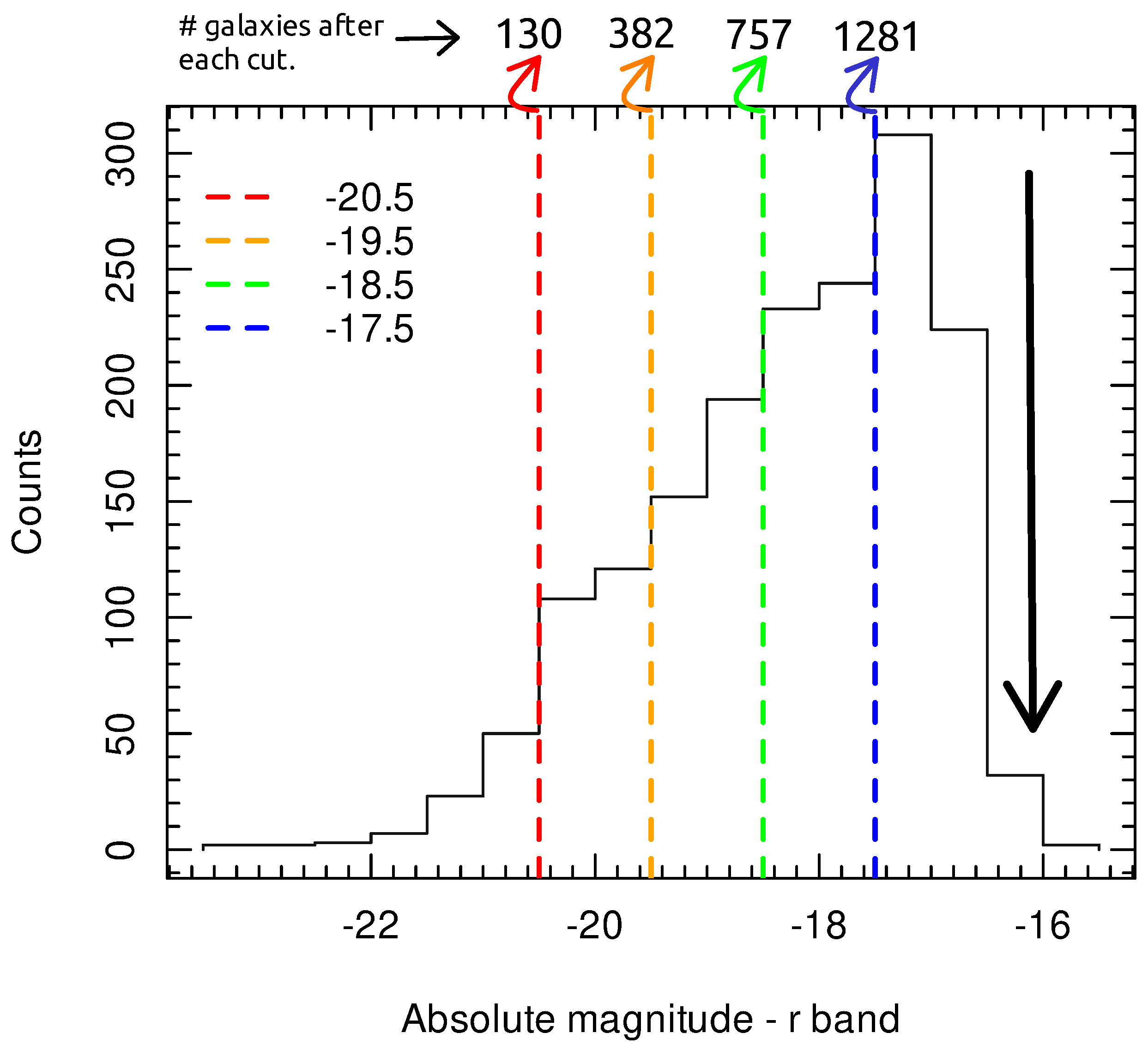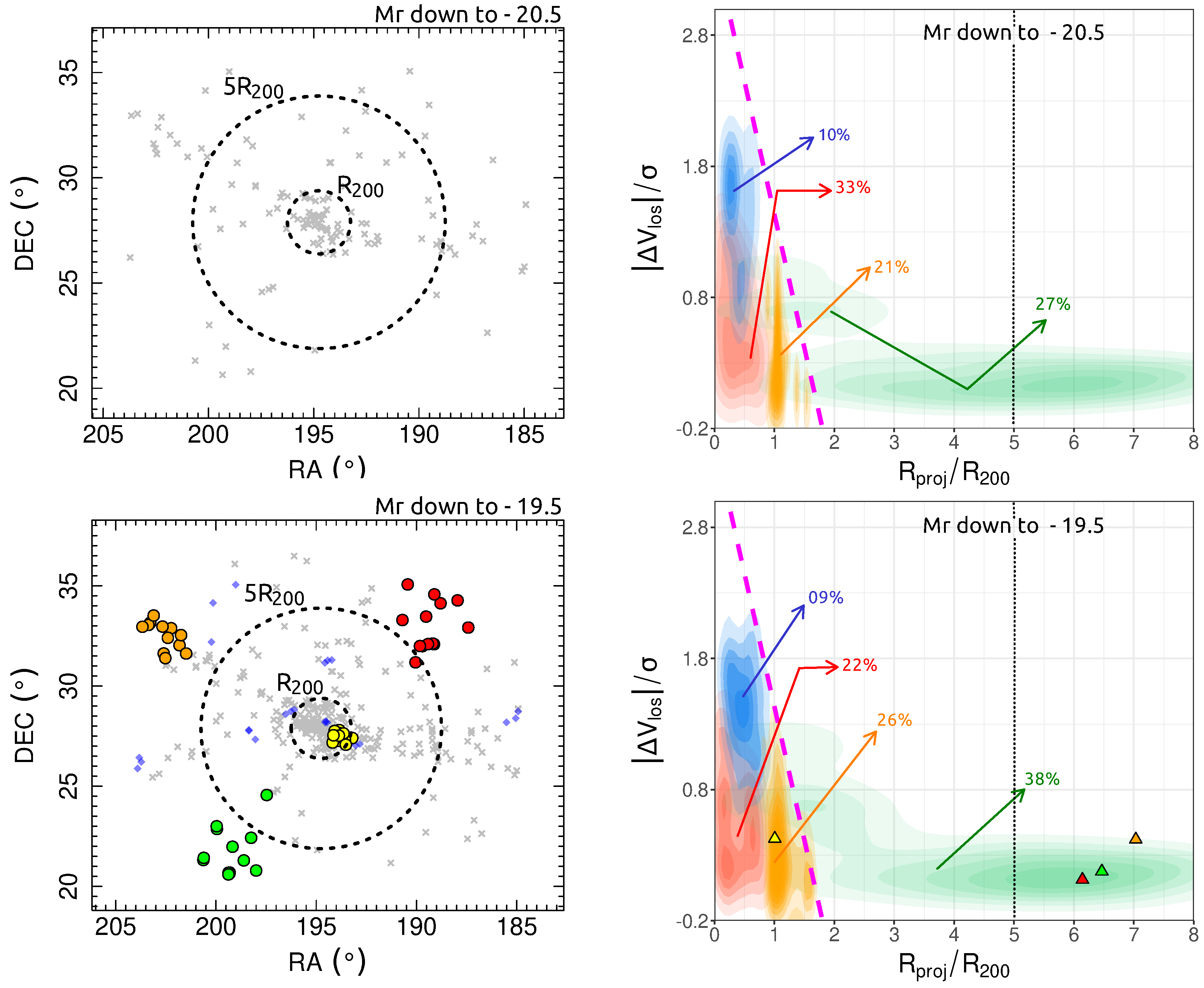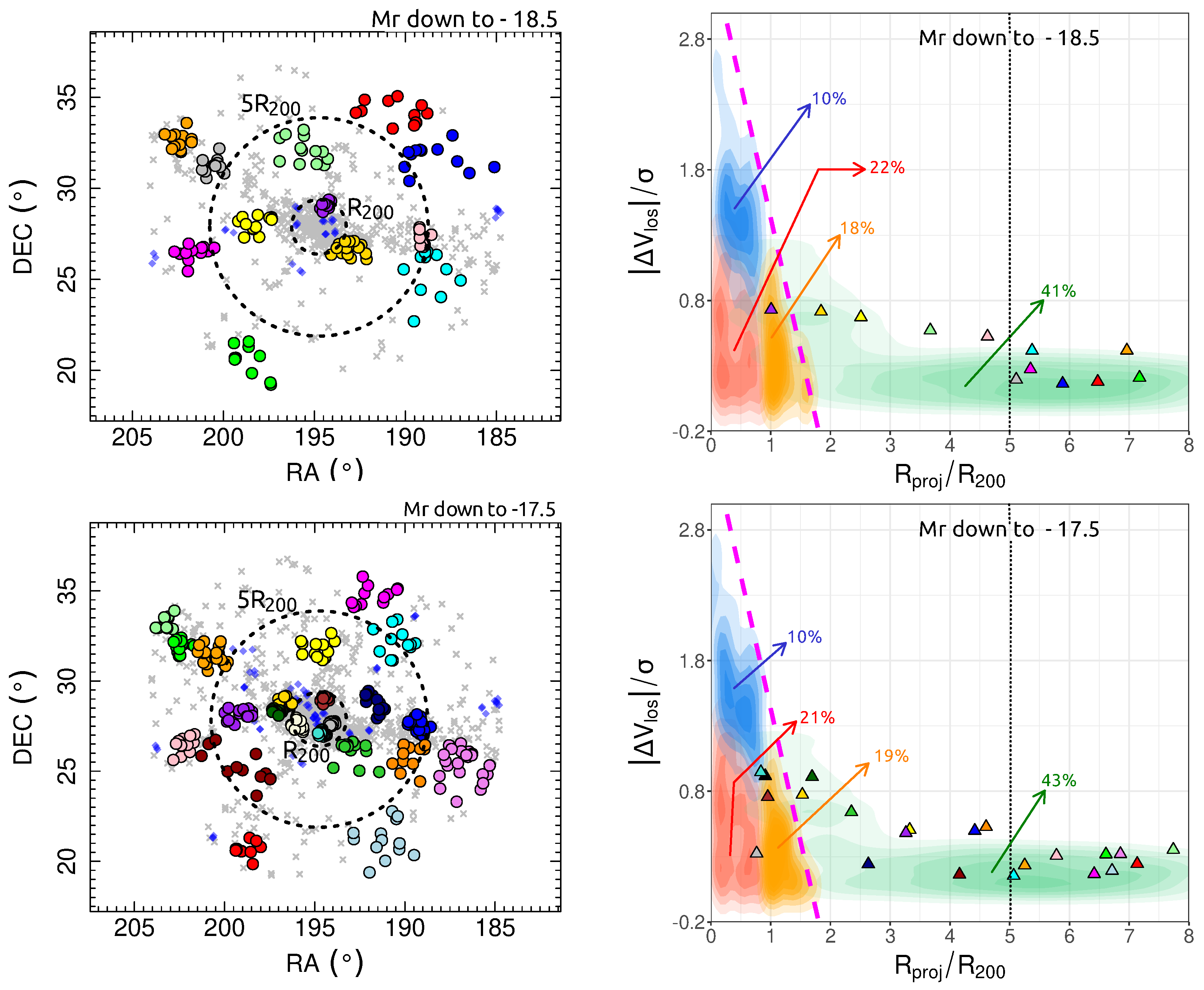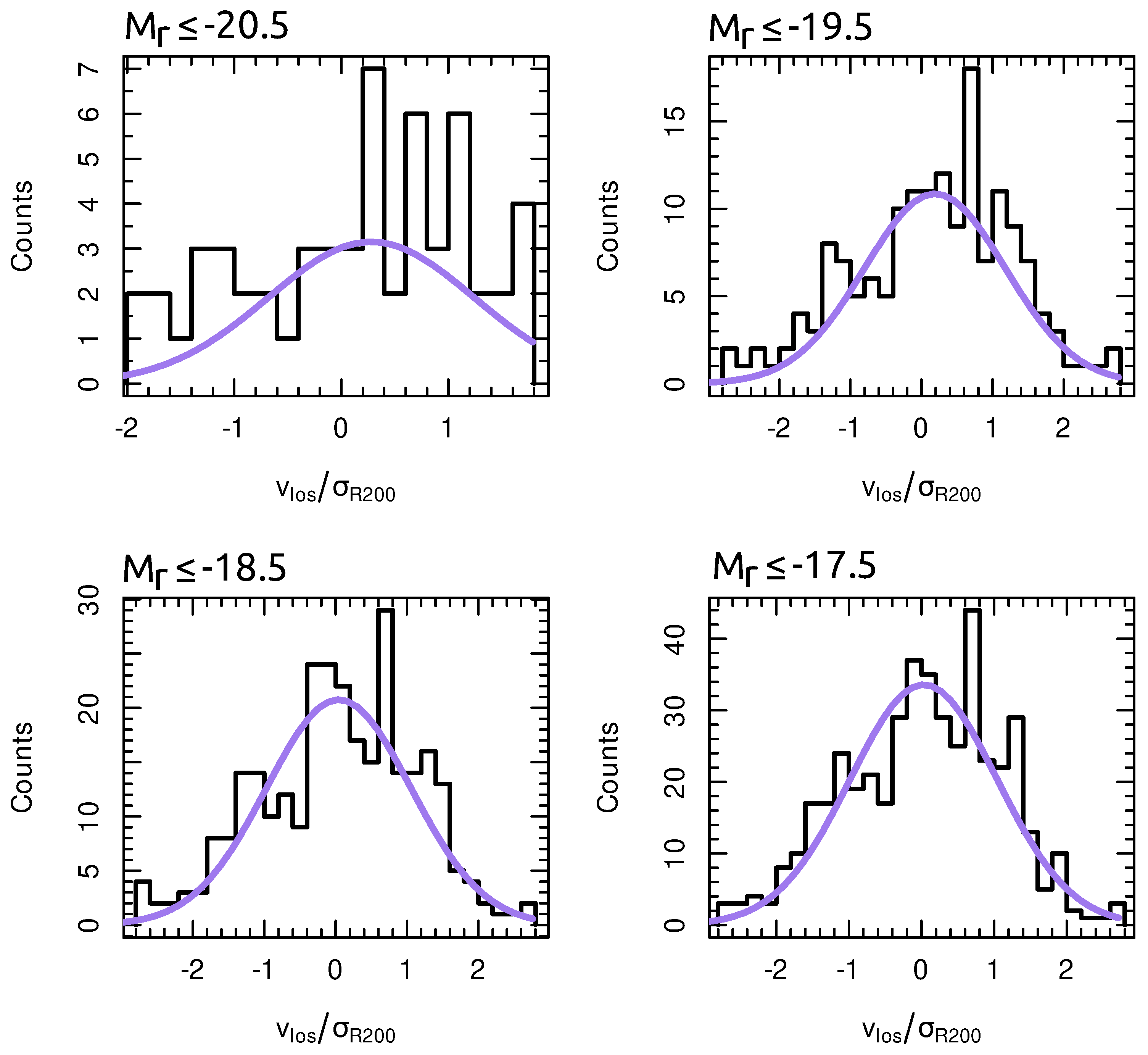Unveiling the Dynamics in Galaxy Clusters: The Hidden Role of Low-Luminosity Galaxies in Coma
Abstract
1. Introduction
2. Data and Methodology
2.1. Data
2.2. Substructure Identification
2.3. Projected Phase-Space Zones
3. Results and Analysis
3.1. DS+ and Galaxy Distribution
3.2. Reliability of Substructures
3.3. Velocity Distributions
4. Discussion
Author Contributions
Funding
Data Availability Statement
Acknowledgments
Conflicts of Interest
| 1 | The authors selected galaxies with and a color index . After applying the necessary approximations to convert between photometric systems, this corresponds to an absolute magnitude of . |
References
- De Lucia, G.; Kauffmann, G.; Springel, V.; White, S.D.M.; Lanzoni, B.; Stoehr, F.; Tormen, G.; Yoshida, N. Substructures in cold dark matter haloes. Mon. Not. R. Astron. Soc. 2004, 348, 333–344. [Google Scholar] [CrossRef]
- Old, L.; Wojtak, R.; Pearce, F.R.; Gray, M.E.; Mamon, G.A.; Sifón, C.; Tempel, E.; Biviano, A.; Yee, H.K.C.; de Carvalho, R.; et al. Galaxy Cluster Mass Reconstruction Project—III. The impact of dynamical substructure on cluster mass estimates. Mon. Not. R. Astron. Soc. 2018, 475, 853–866. [Google Scholar] [CrossRef]
- Whiley, I.M.; Aragón-Salamanca, A.; De Lucia, G.; von der Linden, A.; Bamford, S.P.; Best, P.; Bremer, M.N.; Jablonka, P.; Johnson, O.; Milvang-Jensen, B.; et al. The evolution of the brightest cluster galaxies since z ~1 from the ESO Distant Cluster Survey (EDisCS). Mon. Not. R. Astron. Soc. 2008, 387, 1253–1263. [Google Scholar] [CrossRef]
- Shen, S.; Yang, X.; Mo, H.; van den Bosch, F.; More, S. The Statistical Nature of the Brightest Group Galaxies. Astrophys. J. 2014, 782, 23. [Google Scholar] [CrossRef]
- Mason, C.A.; Trenti, M.; Treu, T. The brightest galaxies at cosmic dawn. Mon. Not. R. Astron. Soc. 2023, 521, 497–503. [Google Scholar] [CrossRef]
- Kaviraj, S.; Tan, K.M.; Ellis, R.S.; Silk, J. A coincidence of disturbed morphology and blue UV colour: Minor-merger-driven star formation in early-type galaxies at z ∼ 0.6. Mon. Not. R. Astron. Soc. 2011, 411, 2148–2160. [Google Scholar] [CrossRef]
- Costa, A.P.; Ribeiro, A.L.B.; de Carvalho, R.R. The shape of velocity dispersion profiles and the dynamical state of galaxy clusters. Mon. Not. R. Astron. Soc. 2018, 473, L31–L35. [Google Scholar] [CrossRef]
- Tanaka, M.; Goto, T.; Okamura, S.; Shimasaku, K.; Brinkmann, J. The environmental dependence of galaxy properties in the local universe: Dependences on luminosity, local density, and system richness. Astron. J. 2004, 128, 2677. [Google Scholar] [CrossRef]
- Berg, D.A.; Skillman, E.D.; Marble, A.R.; van Zee, L.; Engelbracht, C.W.; Lee, J.C.; Kennicutt, R.C., Jr.; Calzetti, D.; Dale, D.A.; Johnson, B.D. Direct Oxygen Abundances for Low-luminosity LVL Galaxies. Astrophys. J. 2012, 754, 98. [Google Scholar] [CrossRef]
- Fitchett, M.; Webster, R. Substructure in the Coma Cluster. Astrophys. J. 1987, 317, 653. [Google Scholar] [CrossRef]
- Gambera, M.; Pagliaro, A.; Antonuccio-Delogu, V.; Becciani, U. A Three-dimensional Wavelet Analysis of Substructure in the Coma Cluster: Statistics and Morphology. Astrophys. J. 1997, 488, 136–145. [Google Scholar] [CrossRef]
- Adami, C.; Biviano, A.; Durret, F.; Mazure, A. The build-up of the Coma cluster by infalling substructures. Astron. Astrophys. 2005, 443, 17–27. [Google Scholar] [CrossRef]
- Churazov, E.; Khabibullin, I.; Lyskova, N.; Sunyaev, R.; Bykov, A.M. Tempestuous life beyond R500: X-ray view on the Coma cluster with SRG/eROSITA. I. X-ray morphology, recent merger, and radio halo connection. Astron. Astrophys. 2021, 651, A41. [Google Scholar] [CrossRef]
- Vikhlinin, A. et al. Chandra Observation of the Coma Cluster: Temperature and Mass Analysis; 2001. [Google Scholar]
- Fadda, D.; Girardi, M.; Giuricin, G.; Mardirossian, F.; Mezzetti, M. The dynamics of galaxy clusters. Astrophys. J. 1996, 473, 670–685. [Google Scholar] [CrossRef]
- Girardi, M.; Fadda, D.; Giuricin, G.; Mardirossian, F.; Mezzetti, M.; Biviano, A. Velocity Dispersions and X-Ray Temperatures of Galaxy Clusters. Astrophys. J. 1996, 457, 61. [Google Scholar] [CrossRef]
- Lopes, P.; De Carvalho, R.; Kohl-Moreira, J.; Jones, C. NoSOCS in SDSS—I. Sample definition and comparison of mass estimates. Mon. Not. R. Astron. Soc. 2009, 392, 135–152. [Google Scholar] [CrossRef]
- Adami, C.; Mazure, A.; Biviano, A.; Katgert, P.; Rhee, G. The ESO nearby Abell cluster survey. IV. The fundamental plane of clusters of galaxies. Astron. Astrophys. 1998, 331, 493–505. [Google Scholar]
- Sohn, J.; Geller, M.J.; Zahid, H.J.; Fabricant, D.G.; Diaferio, A.; Rines, K.J. The velocity dispersion function of very massive galaxy clusters: Abell 2029 and Coma. Astrophys. Suppl. Ser. 2017, 229, 20. [Google Scholar] [CrossRef]
- Balestra, I.; Mercurio, A.; Sartoris, B.; Girardi, M.; Grillo, C.; Nonino, M.; Rosati, P.; Biviano, A.; Ettori, S.; Forman, W.; et al. CLASH-VLT: Dissecting the Frontier Fields Galaxy Cluster MACS J0416. 1-2403 with 800 Spectra of Member Galaxies. Astrophys. Suppl. Ser. 2016, 224, 33. [Google Scholar] [CrossRef]
- Dressler, A.; Shectman, S.A. Evidence for substructure in rich clusters of galaxies from radial-velocity measurements. Astron. J. 1988, 95, 985–995. [Google Scholar] [CrossRef]
- Benavides, J.A.; Biviano, A.; Abadi, M.G. DS+: A method for the identification of cluster substructures. Astron. Astrophys. 2023, 669, A147. [Google Scholar] [CrossRef]
- Costa, A.P.; Ribeiro, A.L.B.; de Carvalho, R.R.; Benavides, J.A. Boosting the evolutionary picture of Cl 0024+17 and MS 0451-03: A case study at intermediate-redshift. Mon. Not. R. Astron. Soc. 2024, 535, 1348–1363. [Google Scholar] [CrossRef]
- de los Rios, M.; Martínez, H.J.; Coenda, V.; Muriel, H.; Ruiz, A.N.; Vega-Martínez, C.A.; Cora, S.A. ROGER: Reconstructing orbits of galaxies in extreme regions using machine learning techniques. Mon. Not. R. Astron. Soc. 2021, 500, 1784–1794. [Google Scholar] [CrossRef]
- Cora, S.A.; Vega-Martínez, C.A.; Hough, T.; Ruiz, A.N.; Orsi, Á.A.; Muñoz Arancibia, A.M.; Gargiulo, I.D.; Collacchioni, F.; Padilla, N.D.; Gottlöber, S.; et al. Semi-analytic galaxies—I. Synthesis of environmental and star-forming regulation mechanisms. Mon. Not. R. Astron. Soc. 2018, 479, 2–24. [Google Scholar] [CrossRef]
- Maturi, M.; Finoguenov, A.; Lopes, P.A.A.; González Delgado, R.M.; Dupke, R.A.; Cypriano, E.S.; Carrasco, E.R.; Diego, J.M.; Penna-Lima, M.; Doubrawa, L.; et al. The miniJPAS survey. Cluster and galaxy group detections with AMICO. Astron. Astrophys. 2023, 678, A145. [Google Scholar] [CrossRef]
- Oman, K.A.; Hudson, M.J.; Behroozi, P.S. Disentangling satellite galaxy populations using orbit tracking in simulations. Mon. Not. R. Astron. Soc. 2013, 431, 2307–2316. [Google Scholar] [CrossRef]
- Agulli, I.; Aguerri, J.A.L.; Diaferio, A.; Dominguez Palmero, L.; Sánchez-Janssen, R. Deep spectroscopy of nearby galaxy clusters—II. The Hercules cluster. Mon. Not. R. Astron. Soc. 2017, 467, 4410–4423. [Google Scholar] [CrossRef]
- Cohn, J.D. Galaxy subgroups in galaxy clusters. Mon. Not. R. Astron. Soc. 2011, 419, 1017–1027. [Google Scholar] [CrossRef]
- Lopes, P.A.; Ribeiro, A.L.; Brambila, D. The role of groups in galaxy evolution: Compelling evidence of pre-processing out to the turnaround radius of clusters. Mon. Not. R. Astron. Soc. Lett. 2024, 527, L19–L25. [Google Scholar] [CrossRef]
- Malavasi, N.; Aghanim, N.; Tanimura, H.; Bonjean, V.; Douspis, M. Like a spider in its web: A study of the large-scale structure around the Coma cluster. Astron. Astrophys. 2020, 634, A30. [Google Scholar] [CrossRef]
- Rhee, J.; Smith, R.; Choi, H.; Sukyoung, K.Y.; Jaffé, Y.; Candlish, G.; Sánchez-Jánssen, R. Phase-space analysis in the group and cluster environment: Time since infall and tidal mass loss. Astrophys. J. 2017, 843, 128. [Google Scholar] [CrossRef]
- Lisker, T.; Weinmann, S.M.; Janz, J.; Meyer, H.T. Dwarf galaxy populations in present-day galaxy clusters—II. The history of early-type and late-type dwarfs. Mon. Not. R. Astron. Soc. 2013, 432, 1162–1177. [Google Scholar] [CrossRef]
- Ribeiro, A.; de Carvalho, R.; Trevisan, M.; Capelato, H.; La Barbera, F.; Lopes, P.; Schilling, A. SPIDER–IX. Classifying galaxy groups according to their velocity distribution. Mon. Not. R. Astron. Soc. 2013, 434, 784–795. [Google Scholar] [CrossRef]
- Barrena, R.; Pizzuti, L.; Chon, G.; Böhringer, H. Unveiling the shape: A multi-wavelength analysis of the galaxy clusters Abell 76 and Abell 1307. Astron. Astrophys. 2024, 691, A135. [Google Scholar] [CrossRef]
- Vijayaraghavan, R.; Gallagher, J.S.; Ricker, P.M. The dynamical origin of early-type dwarfs in galaxy clusters: A theoretical investigation. Mon. Not. R. Astron. Soc. 2015, 447, 3623–3638. [Google Scholar] [CrossRef][Green Version]
- Einasto, M.; Vennik, J.; Nurmi, P.; Tempel, E.; Ahvensalmi, A.; Tago, E.; Liivamägi, L.J.; Saar, E.; Heinämäki, P.; Einasto, J.; et al. Multimodality in galaxy clusters from SDSS DR8: Substructure and velocity distribution. Astron. Astrophys. 2012, 540, A123. [Google Scholar] [CrossRef]
- de Carvalho, R.R.; Ribeiro, A.L.B.; Stalder, D.H.; Rosa, R.R.; Costa, A.P.; Moura, T.C. Investigating the Relation between Galaxy Properties and the Gaussianity of the Velocity Distribution of Groups and Clusters. Astron. J. 2017, 154, 96. [Google Scholar] [CrossRef]
- Healy, J.; Blyth, S.L.; Verheijen, M.A.W.; Hess, K.M.; Serra, P.; van der Hulst, J.M.; Jarrett, T.H.; Yim, K.; Józsa, G.I.G. H I content in Coma cluster substructure. Astrophys. J. 2021, 650, A76. [Google Scholar] [CrossRef]
- Biviano, A.; Durret, F.; Gerbal, D.; Le Fevre, O.; Lobo, C.; Mazure, A.; Slezak, E. Unveiling hidden structures in the Coma cluster. Astrophys. J. 1996, 311, 95–112. [Google Scholar] [CrossRef]
- Beijersbergen, M.; Hoekstra, H.; van Dokkum, P.G.; van der Hulst, T. U-, B- and r-band luminosity functions of galaxies in the Coma cluster. Mon. Not. R. Astron. Soc. 2002, 329, 385–397. [Google Scholar] [CrossRef]
- Fukugita, M.; Shimasaku, K.; Ichikawa, T. Galaxy Colors in Various Photometric Band Systems. Publ. Astron. Soc. Pac. 1995, 107, 945. [Google Scholar] [CrossRef]







| Magnitude Limit | Color Group | Ngal | p-Value | [km/s] | RAgrp [Degree] | DECgrp [Degree] |
|---|---|---|---|---|---|---|
| Mr 19.5 | red | 13 | 0.000 | 108.34 ± 23 | 189.32 | 33.01 |
| green | 13 | 0.000 | 105.77 ± 14 | 199.23 | 21.71 | |
| orange | 14 | 0.001 | 153.95 ± 08 | 202.63 | 32.55 | |
| yellow | 09 | 0.007 | 382.96 ± 57 | 193.82 | 27.44 |
| Magnitude Limit | Color Group | Ngal | p-Value | σgrp [km/s] | RAgrp [Degree] | DECgrp [Degree] |
|---|---|---|---|---|---|---|
| Mr 18.5 | red | 12 | 0.000 | 117.53 ± 03 | 190.43 | 34.22 |
| green | 10 | 0.000 | 131.29 ± 11 | 198.77 | 20.56 | |
| orange | 13 | 0.000 | 223.35 ± 81 | 202.45 | 32.63 | |
| yellow | 14 | 0.000 | 334.65 ± 45 | 198.18 | 28.05 | |
| cyan | 13 | 0.000 | 283.96 ± 52 | 188.72 | 25.52 | |
| magenta | 14 | 0.000 | 154.98 ± 31 | 201.63 | 26.48 | |
| palegreen | 13 | 0.000 | 418.03 ± 12 | 195.53 | 32.10 | |
| gray | 12 | 0.001 | 197.04 ± 15 | 200.55 | 31.20 | |
| pink | 13 | 0.001 | 338.83 ± 95 | 186.05 | 27.17 | |
| blue | 12 | 0.000 | 157.67 ± 44 | 188.55 | 31.71 | |
| purple | 10 | 0.003 | 464.48 ± 88 | 194.42 | 29.03 | |
| gold | 23 | 0.007 | 644.16 ± 51 | 193.08 | 26.72 |
| Magnitude Limit | Final ID Subs | Color Group | Ngal | p-Value | [km/s] | RAgrp [Degree] | DECgrp [Degree] |
|---|---|---|---|---|---|---|---|
| Mr 17.5 | S1 | red | 13 | 0.000 | 145.17 ± 31 | 198.93 | 20.65 |
| S2 | green | 13 | 0.001 | 182.31 ± 13 | 202.40 | 31.94 | |
| S3 | orange | 22 | 0.000 | 204.12 ± 17 | 200.65 | 31.38 | |
| S4 | yellow | 13 | 0.000 | 310.55 ± 25 | 194.78 | 31.75 | |
| S5 | cyan | 12 | 0.000 | 119.36 ± 22 | 190.38 | 32.18 | |
| S6 | magenta | 13 | 0.000 | 122.66 ± 11 | 191.70 | 34.75 | |
| S7 | palegreen | 11 | 0.000 | 147.16 ± 21 | 203.26 | 33.23 | |
| S8 | gray | 13 | 0.000 | 398.76 ± 15 | 194.03 | 27.65 | |
| S9 | pink | 12 | 0.000 | 175.47 ± 15 | 202.20 | 26.45 | |
| S10 | blue | 23 | 0.000 | 365.30 ± 04 | 189.26 | 27.53 | |
| S11 | purple | 13 | 0.000 | 383.66 ± 17 | 199.17 | 28.13 | |
| S12 | gold | 14 | 0.001 | 521.04 ± 09 | 196.67 | 28.84 | |
| S13 | brown | 13 | 0.000 | 360.42 ± 08 | 194.48 | 28.98 | |
| S14 | darkgreen | 13 | 0.000 | 378.82 ± 03 | 197.11 | 28.31 | |
| S15 | lightblue | 12 | 0.000 | 162.03 ± 04 | 191.12 | 21.17 | |
| S16 | darkred | 13 | 0.000 | 155.32 ± 21 | 199.13 | 25.32 | |
| S17 | darkorange | 12 | 0.000 | 408.40 ± 18 | 189.59 | 25.83 | |
| S18 | black | 13 | 0.000 | 412.10 ± 10 | 195.97 | 27.52 | |
| S19 | violet | 24 | 0.000 | 296.85 ± 26 | 186.71 | 25.33 | |
| S20 | turquoise | 14 | 0.001 | 369.28 ± 07 | 194.56 | 27.09 | |
| S21 | limegreen | 13 | 0.001 | 401.93 ± 17 | 192.87 | 26.08 | |
| S22 | navy | 12 | 0.007 | 295.04 ± 19 | 191.67 | 28.80 |
| Magnitude Limit | Excess Kurtosis R ≤ R200 | Skewness R ≤ R200 |
|---|---|---|
Disclaimer/Publisher’s Note: The statements, opinions and data contained in all publications are solely those of the individual author(s) and contributor(s) and not of MDPI and/or the editor(s). MDPI and/or the editor(s) disclaim responsibility for any injury to people or property resulting from any ideas, methods, instructions or products referred to in the content. |
© 2025 by the authors. Licensee MDPI, Basel, Switzerland. This article is an open access article distributed under the terms and conditions of the Creative Commons Attribution (CC BY) license (https://creativecommons.org/licenses/by/4.0/).
Share and Cite
Costa, A.P.; Ribeiro, A.L.B.; de Morais Neto, F.R.; dos Santos Junior, J. Unveiling the Dynamics in Galaxy Clusters: The Hidden Role of Low-Luminosity Galaxies in Coma. Universe 2025, 11, 82. https://doi.org/10.3390/universe11030082
Costa AP, Ribeiro ALB, de Morais Neto FR, dos Santos Junior J. Unveiling the Dynamics in Galaxy Clusters: The Hidden Role of Low-Luminosity Galaxies in Coma. Universe. 2025; 11(3):82. https://doi.org/10.3390/universe11030082
Chicago/Turabian StyleCosta, Alisson P., André L. B. Ribeiro, Flavio R. de Morais Neto, and Juarez dos Santos Junior. 2025. "Unveiling the Dynamics in Galaxy Clusters: The Hidden Role of Low-Luminosity Galaxies in Coma" Universe 11, no. 3: 82. https://doi.org/10.3390/universe11030082
APA StyleCosta, A. P., Ribeiro, A. L. B., de Morais Neto, F. R., & dos Santos Junior, J. (2025). Unveiling the Dynamics in Galaxy Clusters: The Hidden Role of Low-Luminosity Galaxies in Coma. Universe, 11(3), 82. https://doi.org/10.3390/universe11030082






